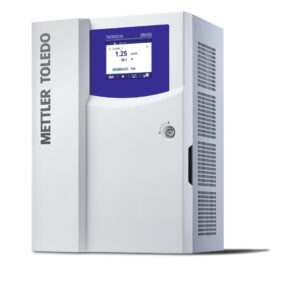
Silica is in all water supplies and requires membrane separation and/or ion exchange for its removal. With ion exchange, it is the most loosely held anionic contaminant and therefore the first to break through an anion or mixed bed ion exchanger.
Monitoring silica in makeup water treatment immediately after anion exchange provides the key parameter for initiating regeneration. Sensing the first silica break-through and stopping the run reduces the operating cost of mixed bed ion exchangers downstream by lowering the frequency of their more expensive and more time-consuming regenerations compared with single bed ion exchangers. Makeup water quality after mixed bed deionization can also be very sensitively monitored at low ppb silica concentrations. Silica has negligible conductivity and therefore cannot be detected using conductivity measurements already present on the outlet of such mixed bed deionizers.
In the water/steam cycle, silica volatilizes with steam and deposits on high pressure turbine blades in a silicate form that is extremely difficult to remove. In the turbine, even a modest thickness of silicate reduces capacity, lowers efficiency and can cause imbalance. In the worst case it can result in thrown blades. Silica also contributes to deposits on heat exchange surfaces and reduces thermal efficiency in other parts of the plant. Silica is always present in cooling water so ppb-level silica measurement is crucial in detecting small condenser leaks and for identifying exhaustion of condensate polishers. As mentioned previously, this sensitivity is needed because conductivity cannot detect silica.
Keeping in mind these varied sources of potential silica contamination and the associated damage, direct, continuous silica measurement is the best means to protect plant assets against contamination.
Silica measurement
Accurate silica measurement requires care in order to achieve consistent results. The measurement uses a molybdate reagent that produces a color change with silica that is detected photometrically. To achieve low level sensitivity, the color change is enhanced using an additional reducing reagent. In boiler drum samples where phosphate is used, the phosphate must be sequestered by a third reagent to prevent interference as phosphate also reacts with molybdates.
Silica measurement also must accommodate changes in sample and optics clarity without drifting.
The design of the METTLER TOLEDO Thornton 2800Si Silica Analyzer is optimized to handle these measurement challenges. With each measurement cycle, it re-zeroes itself on the sample to correct for any changes in optics or sample clarity. The 2800Si then meters in the appropriate amounts of reagents, allows completion of the color change reactions and takes the measurement. After thorough automatic rinsing, it repeats
the measurement cycle based on user-configured timing. This timing can be used to optimize the compromise between response time and reagent consumption.
The 2800Si Analyzer enables unattended automatic calibration at a user-configured interval. It uses a relatively high concentration standard solution that is easy to prepare and handle. The METTLER TOLEDO Thornton 2800Si analyzer is contained in a fully enclosed cabinet to protect reagent containers, tubing and other components from the plant environment.
Large reagent containers enable long service intervals
No calibration
Automated calibration saves operator time and provides excellent repeatability
Tolerates plant environment
The full enclosure safely protects reagent containers and components
Less operator intervention
Simultaneous display of silica and measurement timing provides convenient analyzer status at a glance
 Meeting water/steam cycle chemistry guidelines and turbine warranty requirements demand rapid and precise analytical data. METTLER TOLEDO solutions for the Power industry combine dependable performance with leading-edge technology to give you measurements you can rely on – even at the lowest limits of detection.
Meeting water/steam cycle chemistry guidelines and turbine warranty requirements demand rapid and precise analytical data. METTLER TOLEDO solutions for the Power industry combine dependable performance with leading-edge technology to give you measurements you can rely on – even at the lowest limits of detection.
Our Power industry brochure outlines our portfolio of pH/ORP, conductivity/resistivity, organics, sodium, silica and chloride/sulfate sensors and analyzers.
Some highlights of our offering:
• On-line analyzers that remove the need for lab measurements
• Plug and Measure sensors for error-free measurement point startup
• Predictive diagnostics that keep you informed of sensor/analyzer “health”
Get the Brochure: here
Find out more about the 2800Si silica analyzer: www.mt.com/Thornton-silica
Continuous silica measurement is the best means to protect against contamination from spent anion resin and from steam carryover. Check out how to minimize risks of corrosion with accurate silica monitoring. READ MORE
function db_download_file(){
document.write(”);
return true;}
document.write(”);











